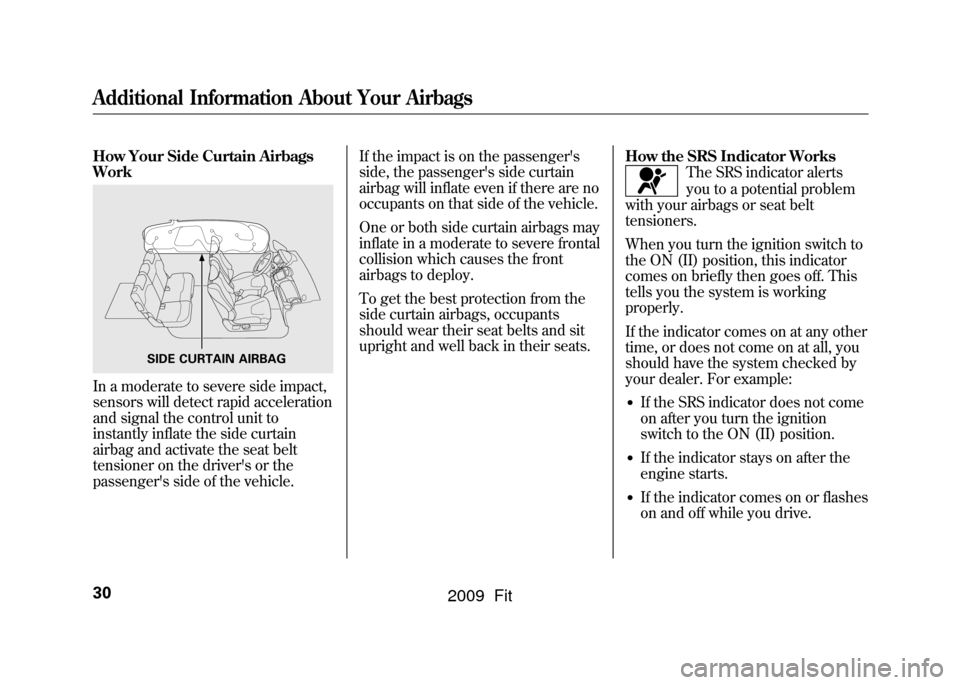2009 HONDA FIT ignition
[x] Cancel search: ignitionPage 21 of 352

Seat Belt System ComponentsYour seat belt system includes lap/
shoulder belts in all seating positions.
The front seat belts are also equipped
with automatic seat belt tensioners.
This system uses the same sensors as
the front airbags to monitor whether
the front seat belts are latched or
unlatched, and how much weight is on
the front passenger's seat (see page
27).
The seat belt system includes
an indicator on the instrument
panel and a beeper to remind you and
your passengers to fasten your seat
belts.
This system monitors the front seat
belts. If you turn the ignition switch to
the ON (II) position before your seat
belt is fastened, the beeper will sound
and the indicator will flash. If your seat
belt is not fastened before the beeper
stops, the indicator will stop flashing
but remain on.
If a front passenger does not fasten
their seat belt, the indicator will
come on about 6 seconds after the
ignition switch is turned to the ON
(II) position.
If either the driver or a front
passenger does not fasten their seat
belt while driving, the beeper will
sound and the indicator will flash
again at regular intervals.
When no one is sitting in the front
passenger's seat, or a child or small
adult is riding there, the indicator
should not come on and the beeper
should not sound. If the indicator comes on or the
beeper sounds when the driver's seat
belt is latched and there is no front
seat passenger and no items on the
front seat, something may be
interfering with the monitoring
system. Look for and remove:
●Any items under the front
passenger's seat.●Any object(s) hanging on the seat
or in the seat-back pocket.●Any object(s) touching the rear of
the seat-back.
If no obstructions are found, have
your vehicle checked by a dealer.
Additional Information About Your Seat Belts18
2009 Fit
Page 27 of 352

●Automatic front seat belt
tensioners (see page20).●Sensors that can detect a moderate
to severe front impact or side
impact.●Sensors that can detect whether a
child is in the passenger's side
airbag path and signal the control
unit to turn the airbag off (see
page29).●Sensors that can detect whether
the driver's seat belt and the front
passenger's seat belt are latched or
unlatched (see page18).●A driver's seat position sensor that
monitors the distance of the seat
from the front airbag. If the seat is
too far forward, the airbag will
inflate with less force (see page
27).
●Weight sensors that monitor the
weight on the front passenger's
seat. If the weight is about 65 lbs
(29 kg) or less (the weight of an
infant or small child), the
passenger's front airbag will be
turned off (see page27).●A sophisticated electronic system
that continually monitors and
records information about the
sensors, the control unit, the
airbag activators, the seat belt
tensioners, and driver and front
passenger seat belt use when the
ignition switch is in the ON (II)
position.●An indicator on the instrument
panel that alerts you to a possible
problem with your airbags,
sensors, or seat belt tensioners
(see page30).
●An indicator on the instrument
panel that alerts you that the
passenger's side airbag has been
turned off (see page31).●An indicator on the dashboard that
alerts you that the passenger's
front airbag has been turned off
(see page31).●Emergency backup power in case
your vehicle's electrical system is
disconnected in a crash.
Additional Information About Your Airbags24
2009 Fit
Page 33 of 352

How Your Side Curtain Airbags
WorkIn a moderate to severe side impact,
sensors will detect rapid acceleration
and signal the control unit to
instantly inflate the side curtain
airbag and activate the seat belt
tensioner on the driver's or the
passenger's side of the vehicle.If the impact is on the passenger's
side, the passenger's side curtain
airbag will inflate even if there are no
occupants on that side of the vehicle.
One or both side curtain airbags may
inflate in a moderate to severe frontal
collision which causes the front
airbags to deploy.
To get the best protection from the
side curtain airbags, occupants
should wear their seat belts and sit
upright and well back in their seats.
How the SRS Indicator Works
The SRS indicator alerts
you to a potential problem
with your airbags or seat belt
tensioners.
When you turn the ignition switch to
the ON (II) position, this indicator
comes on briefly then goes off. This
tells you the system is working
properly.
If the indicator comes on at any other
time, or does not come on at all, you
should have the system checked by
your dealer. For example:
●If the SRS indicator does not come
on after you turn the ignition
switch to the ON (II) position.●If the indicator stays on after the
engine starts.●If the indicator comes on or flashes
on and off while you drive.
SIDE CURTAIN AIRBAG
Additional Information About Your Airbags30
2009 Fit
Page 34 of 352

If you see any of these indications,
the airbags and seat belt tensioners
may not work properly when you
need them.
Ignoring the SRS indicator can
result in serious injury or death
if the airbag systems or
tensioners do not work
properly.
Have your vehicle checked by a
dealer as soon as possible if
the SRS indicator alerts you to
a possible problem.How the Side Airbag Off Indicator
Works
U.S. Canada
This indicator
alerts you that the
passenger's side airbag has been
automatically shut off. It does
not
mean there is a problem with your
side airbags.
When you turn the ignition switch to
the ON (II) position, the indicator
should come on briefly and then go
off (see page61).If it doesn't come
on, stays on, or comes on while
driving without a passenger in the
front seat, have the system checked. How the Passenger Airbag Off
Indicator Works
This indicator alerts you that the
passenger's front airbag has been
shut off because weight sensors
detect about 65 lbs (29 kg) or less
(the weight of an infant or small
child) on the front passenger's seat.
It does
not mean
there is a problem
with the airbag.
PASSENGER AIRBAG
OFF INDICATOR
On vehicle with navigation system U.S.
CONTINUED
Additional Information About Your Airbags
31
Driver and Passenger Safety
2009 Fit
Page 41 of 352

Additional Safety Precautions●Never hold an infant or child onyour lap.
If you are not wearing a
seat belt in a crash, you could be
thrown forward and crush the
child against the dashboard or a
seat-back. If you are wearing a seat
belt, the child can be torn from
your arms and be seriously hurt or
killed.
●Never put a seat belt over yourself
and a child.
During a crash, the
belt could press deep into the child
and cause serious or fatal injuries.
●Never let two children use the
same seat belt.
If they do, they
could be very seriously injured in a
crash.
●Make sure any unused seat belt that a child can reach is buckled,
the lockable retractor is activated,and the belt is fully retracted and
locked.
If a child wraps a loose
seat belt around their neck, they
can be seriously or fatally injured.
(See pages 45and 46for how to
activate and deactivate the
lockable retractor.)
●Use the childproof door locks to prevent children from opening the
rear doors.
This can prevent
children from accidentally falling
out (see page82).
●Do not leave children alone in a
vehicle.
Leaving children without
adult supervision is illegal in most
states and Canadian provinces, and
can be very hazardous. For example, infants and small
children left in a vehicle on a hot
day can die from heatstroke. A
child left alone with the key in the
ignition switch can accidentally set
the vehicle in motion, possibly
injuring themselves or others.
●Lock all doors and the tailgate
when your vehicle is not in use.Children who play in vehicles can
accidentally get trapped inside.
Teach your children not to play in
or around vehicles.●Keep vehicle keys/remotetransmitters out of the reach of
children.
Even very young
children learn how to unlock
vehicle doors, turn on the ignition
switch, and open the tailgate,
which can lead to accidental injury
or death.
Protecting Children -General Guidelines38
2009 Fit
Page 60 of 352

This section gives information about
the controls and displays that
contribute to the daily operation of
your vehicle. All the essential
controls are within easy reach.Control Locations
..........................
58
Instrument Panel
..........................
59
Instrument Panel Indicators
..........
60
Gauges
..........................................
68
Trip Meter
................................
69
Current Fuel Mileage
................
70
Average Fuel Mileage
...............
70
Odometer
..................................
70
Fuel Gauge
...............................
70
Check Fuel Cap Indicator
.........
70
Maintenance Minder
................
71
Controls Near the Steering
Wheel
.......................................
72
Windshield Wipers and Washers
................................
73
Windshield Wipers
...................
73
Rear Window Wiper and
Washer
.................................
73
Turn Signal and Headlights
..........
74
Headlights
....................................
75
Instrument Panel Brightness
........
76
Hazard Warning Button
................
76
Rear Window Defogger
.................
76
Steering Wheel Adjustment
..........
77
Keys and Locks
.............................
78 Immobilizer System
......................
79
Ignition Switch
..............................
80
Door Locks
...................................
81
Power Door Locks
....................
81
Childproof Door Locks
..............
82
Auto Door Locking/
Unlocking
.............................
83
Auto Door Locking
...................
83
Auto Door Unlocking
................
85
Tailgate
.........................................
88
Remote Transmitter
......................
90
Seats
.............................................
93
Power Windows
..........................
100
Mirrors
.......................................
101
Parking Brake
.............................
102
Interior Convenience Items
.........
104
Lower Glove Box
....................
105
Upper Glove Box
.....................
105
Beverage Holders
...................
106
Seat Under Box
.......................
106
Accessory Power Socket
.........
106
Sun Visor
................................
106
Interior Lights
.............................
107
Instruments and Controls
57
Instruments and Controls
2009 Fit
Page 63 of 352

The instrument panel has many
indicators that give you important
information about your vehicle.
Malfunction Indicator
Lamp
See page304.Low Oil Pressure
Indicator
The engine can be severely damaged
if this indicator flashes or stays on
when the engine is running. For
more information, see page303.Charging System
Indicator
If this indicator comes on when the
engine is running, the battery is not
being charged. For more
information, see page303.
U.S. Canada
Parking Brake
and Brake
System Indicator
(Red)
This indicator has two functions:
1. It comes on when you turn the ignition switch to the ON (II)
position. It is a reminder to check
the parking brake. A beeper
sounds if you drive with the
parking brake not fully released.
Driving with the parking brake not
fully released can damage the
brakes and tires.
2. If it remains on after you have fully released the parking brake while
the engine is running, or if it
comes on while driving, there
could be a problem with the brake
system. For more information, see
page305.
Seat Belt Reminder
Indicator
This indicator comes on when you
turn the ignition switch to the ON
(II) position. It reminds you and your
passengers to fasten your seat belts.
A beeper also sounds if you have not
fastened your seat belt.
If you turn the ignition switch to the
ON (II) position before fastening
your seat belts, the beeper sounds,
and the indicator flashes. If you do
not fasten your seat belts before the
beeper stops, the indicator stops
flashing but remains on.
Instrument Panel Indicators60
2009 Fit
Page 64 of 352

If your front passenger does not
fasten their seat belt, the indicator
comes on about 6 seconds after the
ignition switch is turned to the ON
(II) position.
If either of you do not fasten your
seat belt while driving, the beeper
will sound and the indicator will flash
again at regular intervals. For more
information, see page18.
Supplemental Restraint
System Indicator
This indicator comes on briefly when
you turn the ignition switch to the
ON (II) position. If it comes on at any
other time, it indicates a potential
problem with your front airbags. This
indicator will also alert you to a
potential problem with your side
airbags, passenger's side airbag
cutoff system, side curtain airbags,
automatic seat belt tensioners,
driver's seat position sensor, or the
front passenger's weight sensors.
For more information, see page30.
U.S. Canada
Side Airbag Off
Indicator
This indicator comes on briefly when
you turn the ignition switch to the
ON (II) position. If it comes on at any
other time, it indicates that the
passenger's side airbag has
automatically shut off. For more
information, see page31.
CONTINUED
Instrument Panel Indicators
61
Instruments and Controls
2009 Fit